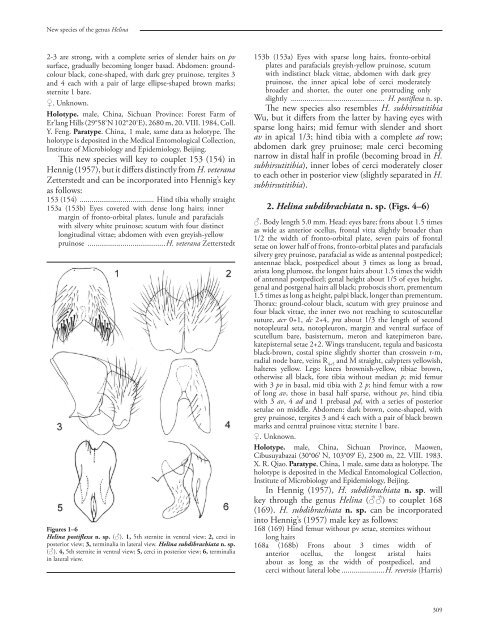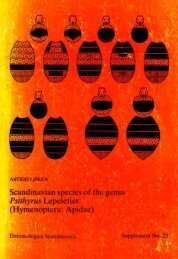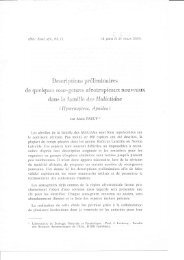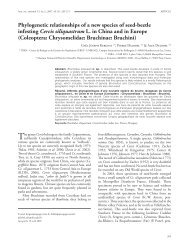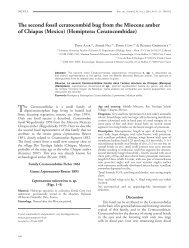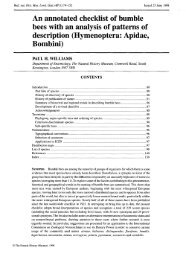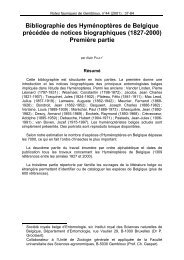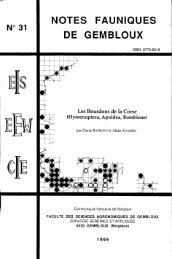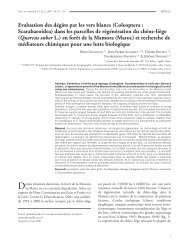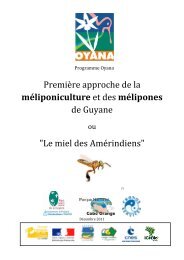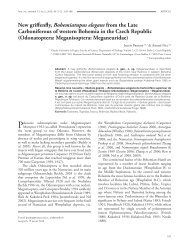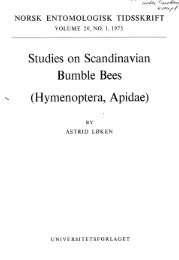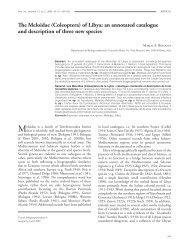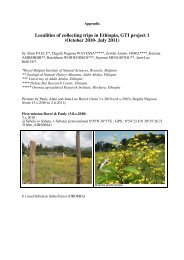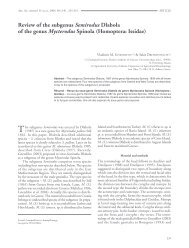ASEF 3-2008.indb - Laboratoire de Zoologie
ASEF 3-2008.indb - Laboratoire de Zoologie
ASEF 3-2008.indb - Laboratoire de Zoologie
You also want an ePaper? Increase the reach of your titles
YUMPU automatically turns print PDFs into web optimized ePapers that Google loves.
New species of the genus Helina<br />
2-3 are strong, with a complete series of slen<strong>de</strong>r hairs on pv<br />
surface, gradually becoming longer basad. Abdomen: groundcolour<br />
black, cone-shaped, with dark grey pruinose, tergites 3<br />
and 4 each with a pair of large ellipse-shaped brown marks;<br />
sternite 1 bare.<br />
♀. Unknown.<br />
Holotype. male, China, Sichuan Province: Forest Farm of<br />
Er’lang Hills (29°58‘N 102°20‘E), 2680 m, 20. VIII. 1984, Coll.<br />
Y. Feng. Paratype. China, 1 male, same data as holotype. The<br />
holotype is <strong>de</strong>posited in the Medical Entomological Collection,<br />
Institute of Microbiology and Epi<strong>de</strong>miology, Beijing.<br />
This new species will key to couplet 153 (154) in<br />
Hennig (1957), but it differs distinctly from H. veterana<br />
Zetterstedt and can be incorporated into Hennig’s key<br />
as follows:<br />
153 (154) ...................................... Hind tibia wholly straight<br />
153a (153b) Eyes covered with <strong>de</strong>nse long hairs; inner<br />
margin of fronto-orbital plates, lunule and parafacials<br />
with silvery white pruinose; scutum with four distinct<br />
longitudinal vittae; abdomen with even greyish-yellow<br />
pruinose ........................................H. veterana Zetterstedt<br />
Figures 1–6<br />
Helina postiflexa n. sp. (♂). 1, 5th sternite in ventral view; 2, cerci in<br />
posterior view; 3, terminalia in lateral view. Helina subdibrachiata n. sp.<br />
(♂). 4, 5th sternite in ventral view; 5, cerci in posterior view; 6, terminalia<br />
in lateral view.<br />
153b (153a) Eyes with sparse long hairs, fronto-orbital<br />
plates and parafacials greyish-yellow pruinose, scutum<br />
with indistinct black vittae, abdomen with dark grey<br />
pruinose, the inner apical lobe of cerci mo<strong>de</strong>rately<br />
broa<strong>de</strong>r and shorter, the outer one protruding only<br />
slightly ................................................ H. postifl exa n. sp.<br />
The new species also resembles H. subhirsutitibia<br />
Wu, but it differs from the latter by having eyes with<br />
sparse long hairs; mid femur with slen<strong>de</strong>r and short<br />
av in apical 1/3; hind tibia with a complete ad row;<br />
abdomen dark grey pruinose; male cerci becoming<br />
narrow in distal half in profile (becoming broad in H.<br />
subhirsutitibia), inner lobes of cerci mo<strong>de</strong>rately closer<br />
to each other in posterior view (slightly separated in H.<br />
subhirsutitibia).<br />
2. Helina subdibrachiata n. sp. (Figs. 4–6)<br />
♂. Body length 5.0 mm. Head: eyes bare; frons about 1.5 times<br />
as wi<strong>de</strong> as anterior ocellus, frontal vitta slightly broa<strong>de</strong>r than<br />
1/2 the width of fronto-orbital plate, seven pairs of frontal<br />
setae on lower half of frons, fronto-orbital plates and parafacials<br />
silvery grey pruinose, parafacial as wi<strong>de</strong> as antennal postpedicel;<br />
antennae black, postpedicel about 3 times as long as broad,<br />
arista long plumose, the longest hairs about 1.5 times the width<br />
of antennal postpedicel; genal height about 1/5 of eyes height,<br />
genal and postgenal hairs all black; proboscis short, prementum<br />
1.5 times as long as height, palpi black, longer than prementum.<br />
Thorax: ground-colour black, scutum with grey pruinose and<br />
four black vittae, the inner two not reaching to scutoscutellar<br />
suture, acr 0+1, dc 2+4, pra about 1/3 the length of second<br />
notopleural seta, notopleuron, margin and ventral surface of<br />
scutellum bare, basisternum, meron and katepimeron bare,<br />
katepisternal setae 2+2. Wings translucent, tegula and basicosta<br />
black-brown, costal spine slightly shorter than crossvein r-m,<br />
radial no<strong>de</strong> bare, veins R 4+5<br />
and M straight, calypters yellowish,<br />
halteres yellow. Legs: knees brownish-yellow, tibiae brown,<br />
otherwise all black, fore tibia without median p; mid femur<br />
with 3 pv in basal, mid tibia with 2 p; hind femur with a row<br />
of long av, those in basal half sparse, without pv, hind tibia<br />
with 3 av, 4 ad and 1 prebasal pd, with a series of posterior<br />
setulae on middle. Abdomen: dark brown, cone-shaped, with<br />
grey pruinose, tergites 3 and 4 each with a pair of black brown<br />
marks and central pruinose vitta; sternite 1 bare.<br />
♀. Unknown.<br />
Holotype. male, China, Sichuan Province, Maowen,<br />
Cibusuyabazai (30°06′ N, 103°09′ E), 2300 m, 22. VIII. 1983.<br />
X. R. Qiao. Paratype, China, 1 male, same data as holotype. The<br />
holotype is <strong>de</strong>posited in the Medical Entomological Collection,<br />
Institute of Microbiology and Epi<strong>de</strong>miology, Beijing.<br />
In Hennig (1957), H. subdibrachiata n. sp. will<br />
key through the genus Helina (♂♂) to couplet 168<br />
(169). H. subdibrachiata n. sp. can be incorporated<br />
into Hennig’s (1957) male key as follows:<br />
168 (169) Hind femur without pv setae, sternites without<br />
long hairs<br />
168a (168b) Frons about 3 times width of<br />
anterior ocellus, the longest aristal hairs<br />
about as long as the width of postpedicel, and<br />
cerci without lateral lobe ......................H. reversio (Harris)<br />
309


